List Each Veal Primal and Describe Its Location on the Carcass beef
Veal - Meat cuts manual
PDF - bilingual (1241 kb)
On this page
Diagram of meat cuts
Skeletal diagram
Meat cut nomenclature and description
- 1. Veal
- 2. Dressed veal carcass
- 2.1 Front quarter
- 2.2 Hind quarter
- 3. Side
- 3.1 Front quarter
- 3.2 Hind quarter
- 4. Front - Front, double
- 4.1 Neck
- 4.2 Shoulder - Shoulder, double
- 4.3 Breast
- 4.4 Shank
- 5. Leg - Leg, double
- 5.1 Shank
- 5.2 Leg, shank portion
- 5.3 Leg, butt portion
- 5.4 Heel of round
- 5.5 Sirloin tip
- 5.6 Sirloin - Sirloin, double
- 5.7 Leg, short cut
- 5.8 Rump
- 5.9 Round
- 5.10 Inside round
- 5.11 Outside round
- 5.12 Eye of round
- 6. Whole loin - Whole loin, double
- 6.1 Loin - Loin, double
- 6.2 Rib - Rib, double
- 7. Flank
- 8. Rib and flank
List of meat cut modifiers
Variety meats
Veal - Diagram of meat cuts
Click on image for larger view
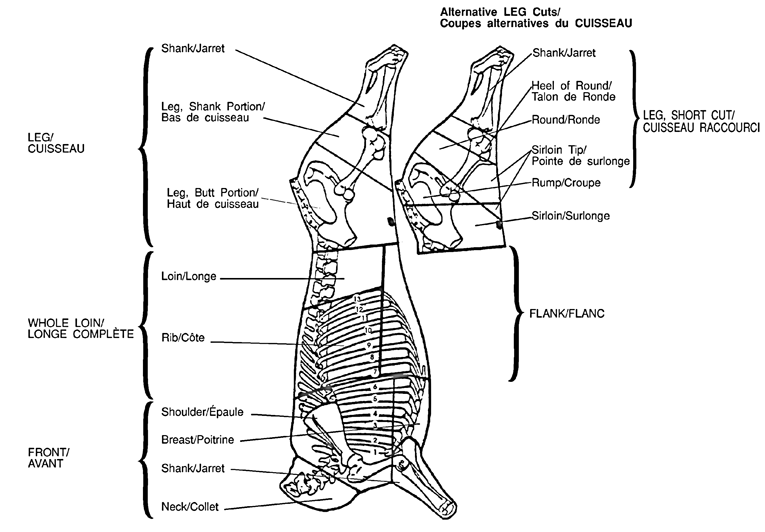
Description for photo - Diagram of meat cuts - Veal
This diagram shows the meat cuts from veal. Veal consists of the leg, the whole loin, the front, and the flank.
- The leg consists of the following cuts:
- shank
- leg, shank portion
- leg, butt portion
- The whole loin consists of the following cuts:
- loin
- rib
- The front consists of the following cuts:
- shoulder
- breast
- shank
- neck
- Alternative leg cut consists of the leg, short cut. The leg, short cut consists of the following:
- shank
- heel of round
- round
- sirloin tip
- rump
- sirloin
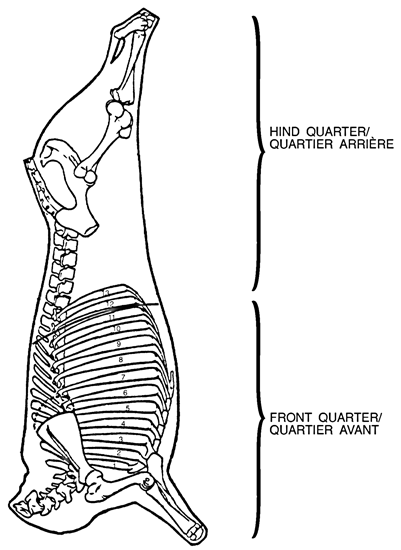
Description for photo - Diagram of meat cuts - Alternative cuts - Side veal
This diagram shows alternatives cuts of a side veal.
The alternative cuts of a side veal includes the following elements:
- hind quarter
- front quarter
Click on image for larger view

Description for photo - Diagram of meat cuts - Alternative cuts - Carcass
This diagram shows the alternative cuts of a veal carcass.
Alternative cuts of a veal carcass consist of:
- whole loin, double - which consists of: loin and rib, double
- front, double - which consists of: shoulder, double
- rib and flank, double
- sirloin, double
- leg, double
Veal - Skeletal diagram
Click on image for larger view
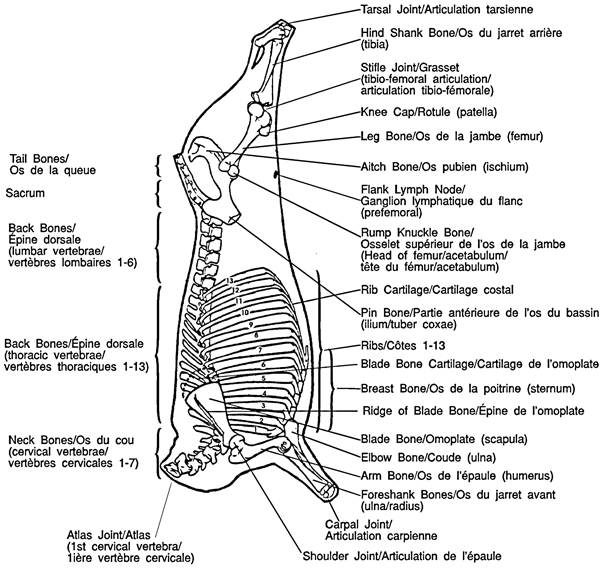
Description for photo - Diagram of meat cuts - Skeletal diagram of veal
This diagram shows the skeletal diagram of veal. It consists of:
- tail bones
- sacrum
- back bones (lumbar vertebrae 1 to 6)
- back bones (thoracic vertebrae 1 to 13)
- neck bones (cervical vertebrae 1 to 7)
- atlas (1st cervical vertebra)
- shoulder joint
- carpal joint
- foreshank bones (radius/ulna)
- arm bone (humerus)
- elbow bone (ulna)
- blade bone (scapula)
- ridge of blade bone
- breast bone (sternum)
- blade bone cartilage
- ribs 1 to 13
- pin bone (ilium)
- rib cartilage
- rump knuckle bone (head of femur/acetabulum)
- flank lymph node (prefemoral)
- aitch bone (ischium)
- leg bone (femur)
- knee cap (patella)
- stifle joint (tibio-femoral articulation)
- hind shank bone (tibia)
- tarsal joint
Meat cut nomenclature and description
1. Veal: is meat derived from dressed carcasses of bovine animals having the maturity characteristics set out in Schedule IX of the Beef, Bison and Veal Carcass Grade Requirements – PDF (260 kb) and a warm carcass weight of 190 kg or less with the hide removed.
Maturity characteristics
- Bones that are soft and reddish in colour
- Ribs that are narrow and slightly rounded
- A sternum that shows distinct divisions
- An aitch bone (ischium) that is covered by cartilage
2. Dresssed veal carcass: means a veal carcass from which the skin, head and feet at the carpal and tarsal joints have been removed and the carcass has been eviscerated.
2.1 Front half: means the anterior portion of the dressed veal carcass which is separated from the hind half by a cut following the natural curvature between the eleventh (11th) and twelfth (12th) rib.
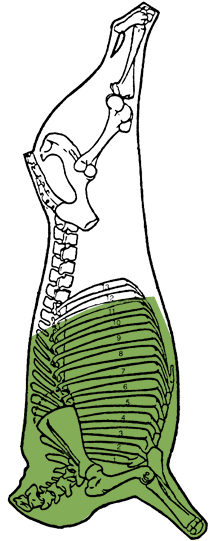
2.2 Hind half: means the posterior portion of the dressed veal carcass which is separated from the front half, as described.
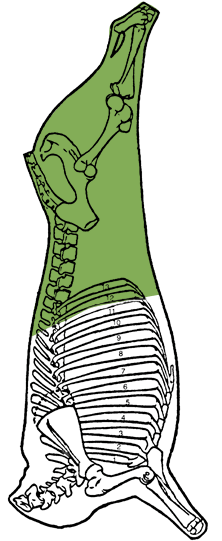
3. Side: means one (1) of the two (2) approximately equal portions of a dressed veal carcass obtained by cutting from the tail to the neck along the median line.
3.1 Front quarter: means the anterior portion of the side which is separated from the hind quarter by a cut following the natural curvature between the eleventh (11th) and twelfth (12th) rib.
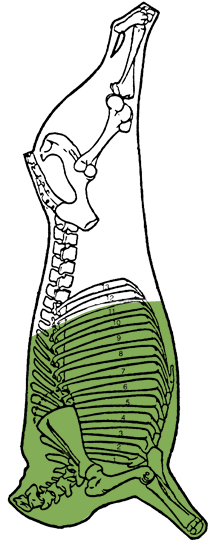
3.2 Hind quarter: means the posterior portion of the side which is separated from the front quarter, as described.

4. Front: means that portion of the side which is separated from the whole loin and flank by cutting (ribbing) between the sixth (6th) and seventh (7th) rib.
Front, double: means the anterior portion of the front half which is separated from the rib and flank, double by a straight cut passing between the sixth (6th) and seventh (7th) rib.

4.1 Neck: means that portion of the front which is separated from the shoulder by a straight cut passing through the fifth (5th) neck bone (cervical vertebra).
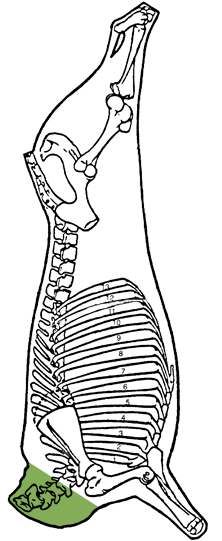
4.2 Shoulder: means that portion of the front which is separated from the neck as described in item 4.1, and from the breast and shank by a straight cut which passes through the base of the shaft of the arm bone (distal extremity of the humerus).
Shoulder, double: means that portion of the front, double which is separated from the neck, breast and shank as described.

4.3 Breast: means that portion of the front which is separated from the shoulder as described in item 4.2, and from the shank by a cut which follows the natural (dividing) seam.
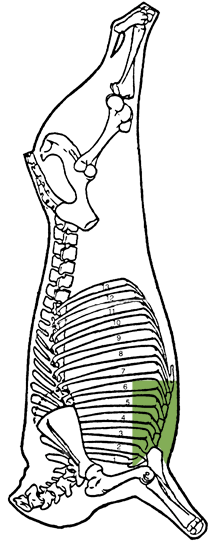
4.4 Shank (foreshank): means that portion of the front which is separated from the shoulder and breast as described in items 4.2 and 4.3.

5. Leg: means the posterior of the side which is separated from the whole loin and flank by a straight cut which passes in front of (anterior to) the pin bone (ilium or tuber coxae).
Leg, double: means the posterior portion of the hind half which is separated from the loin, double and flank by a straight cut passing immediately in front of (anterior to) the pin bone (ilium or tuber coxae).
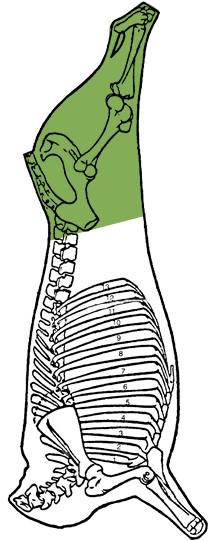
5.1 Shank (hind shank): means that portion of the leg which is separated from the leg, shank portion or heel of round by a straight cut passing through the stifle joint (tibio-femoral joint).
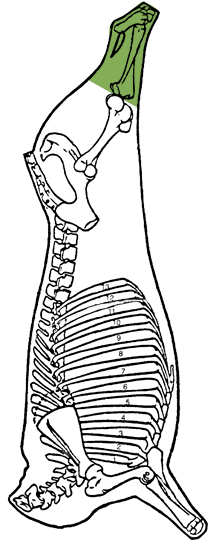
5.2 Leg, shank portion (leg, shank end): means that portion of the leg which is separated from the shank as described in item 5.1, and from the leg, butt portion by a straight cut which passes approximately through the centre of the shaft of the leg bone (femur) approximately at right angles to it.
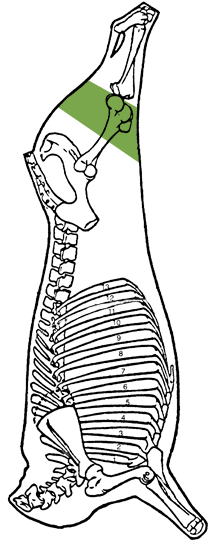
5.3 Leg, butt portion (leg, butt end): means that portion of the leg which is separated from the leg, shank portion as described in item 5.2.
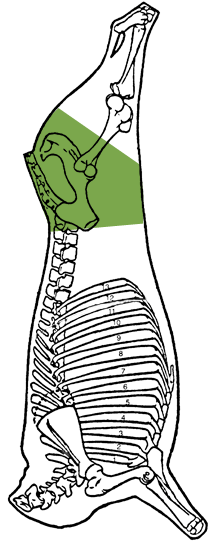
5.4 Heel of round: is an alternative portion of the leg which is separated from the shank as described in item 5.1, and from the round by a straight cut passing through the base of the shaft of the leg bone (distal extremity of the femur).

5.5 Sirloin tip: is an alternative portion of the leg obtained by a "V-shaped" cut beginning at the knee cap (patella) and following the full length of the leg bone (femur) up to the rump knuckle bone (head of femur/acetabulum) then towards the flank lymph node (prefemoral).
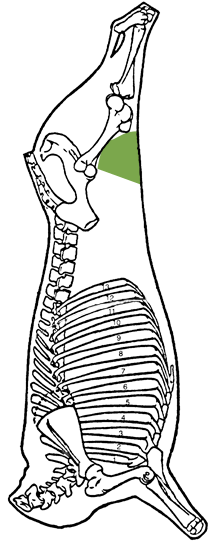
5.6 Sirloin: is an alternative portion of the leg which is separated from the sirloin tip as described in item 5.5, and from the rump by a straight cut which passes in front of (anterior to) the rump knuckle bone (head of femur/acetabulum).
Sirloin, double: means the anterior portion of the leg, double which is separated from the leg, short cut, as described.
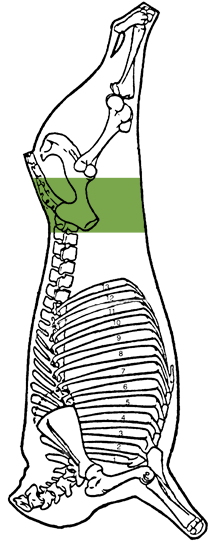
5.7 Leg, short cut: means the leg from which the sirloin has been removed.
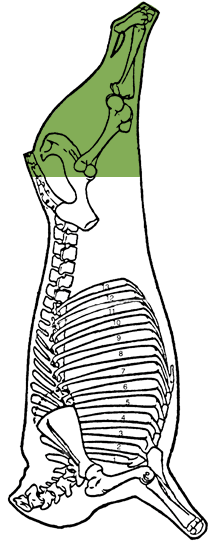
5.8 Rump: is an alternative portion of the leg which is separated from the sirloin as described in item 5.6, and from the round by a straight cut approximately parallel and behind (posterior to) the aitch bone (ischium).
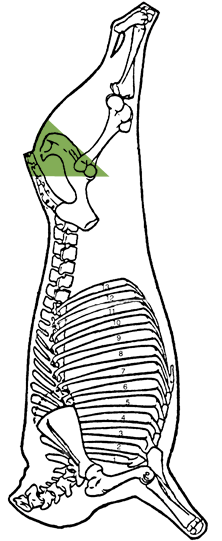
5.9 Round: is an alternative portion of the leg which is separated from the sirloin tip and rump, as described in items 5.5 and 5.8, respectively, and from the heel of round by a straight cut which passes through the base of the shaft of the leg bone (distal extremity of the femur). The cut may extend into the rump.
Note: The round contains no part of the gastrocnemius muscle.
5.10 Inside round: see beef
5.11 Outside round: see beef
5.12 Eye of round: see beef
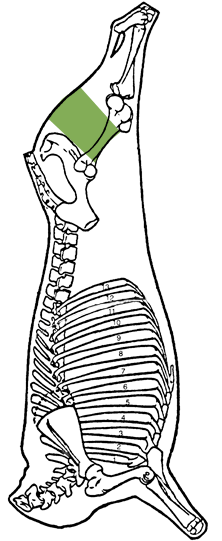
6. Whole loin: means that portion of the side which is separated from the front and leg as described in items 4 and 5, respectively, and from the flank by a straight cut approximately parallel to the back bones (vertebral column) passing at a point slightly above (dorsal to) the costal cartilage of the twelfth (12th) rib.
Whole loin, double: means that portion of the dressed veal carcass which is separated from the front, double and leg, double as described, and from the flanks, by a straight cut approximately parallel to the back bones (vertebral column) passing through the thirteenth (13th) rib, approximately at the beginning of the costal cartilage. It consists of the loin, double and rib (rack), double, attached.
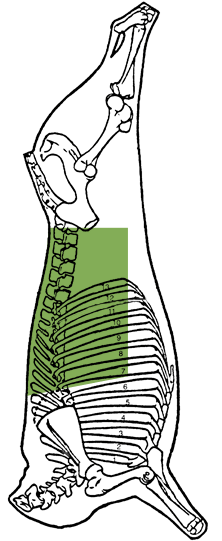
6.1 Loin: means the posterior portion of the whole loin which is separated from the rib by a straight cut which passes behind (posterior to) the last rib (13th rib).
Note: The loin contains no part of a rib.
Loin, double: means the posterior portion of the whole loin, double which is separated from the rib, (rack) double by a straight cut passing behind (posterior to) the last rib (13th rib).
6.1.1 Strip loin: see beef
6.1.2 Tenderloin: see beef

6.2 Rib: means the anterior portion of the whole loin which is separated from the loin as described in item 6.1.
Note: The complete rib or part thereof prepared as roast, may be referred to as rack.
Rib (rack), double: means the anterior portion of the whole loin, double which is separated from the loin, double, as described.
6.2.1 Rib eye: see beef
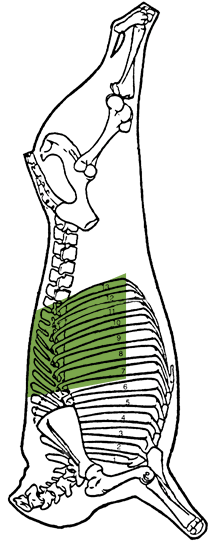
7. Flank: means that portion of the side which is separated from the front, leg and whole loin as described in items 4, 5 and 6, respectively.
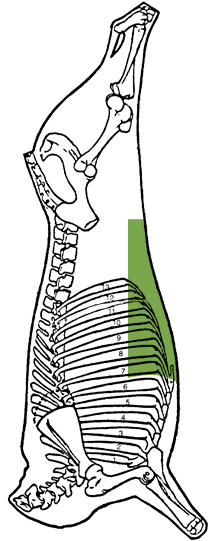
8. Rib (rack) and flank, double: means the posterior portion of the front half which is separated from the front, double, as described. It consists of the rib (rack) and the rib portion of the flank, attached.
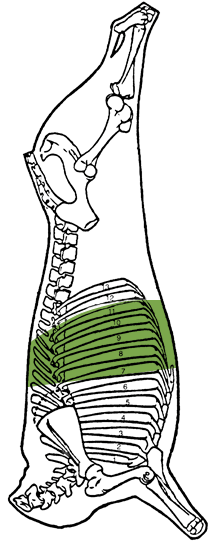
List of meat cut modifiers
- Bone in / De coquille
- Boneless / Désossé(e)
- Cap removed / Paré
- Chop / Côtelette
- Cutlet / Escalope
- Delicatize(d) or Delicated / Attendri(re) mécaniquement
- Diced veal / Veau en cubes
- Frenched rib chop / Côtelette à manche
- Medallion / Médaillon
- Portion / Partie du
- Rack / Carré
- Roast / Rôti
- Rolled / Roulé
- Scallopine / Escalope milanaise
- Semi-boneless / Semi-désossé(e)
- Steak / Tranche
- Stewing veal / Veau à ragoût
- Stuffed / Farci(e)
- Tenderize(d) / Attendri(r)
- Tied / Ficelé
- Trimmed / Paré
Note: While not required, these modifiers may be used to describe veal cuts provided they are informative and not misleading.
Variety meats
- brain / cervelle
- heart / cœur
- kidney / rognon
- liver / foie
- sweetbread / ris
- tongue / langue
- Date modified:
Source: https://inspection.canada.ca/food-labels/labelling/industry/meat-and-poultry-products/meat-cuts/veal/eng/1348771541038/1348771745050
0 Response to "List Each Veal Primal and Describe Its Location on the Carcass beef"
Post a Comment